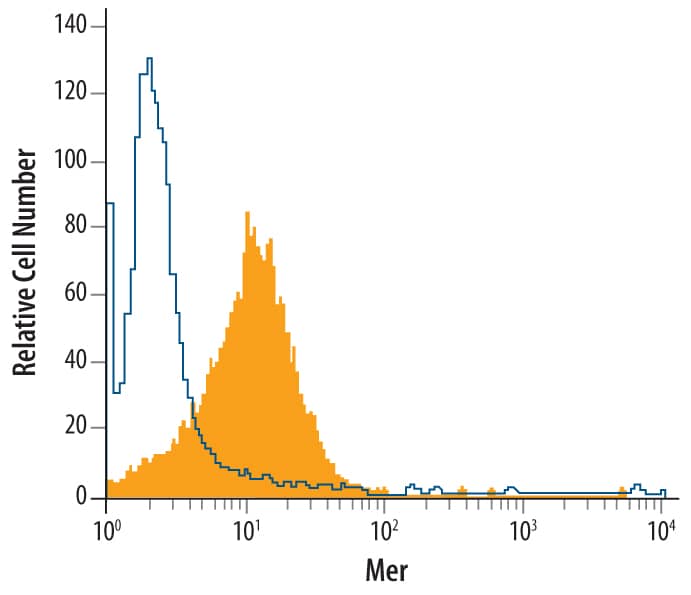Recombinant Mouse IGFBP-4 Protein Summary
Product Specifications
Asp22-Glu254
Analysis
Customers also Viewed
Product Datasheets
Carrier Free
CF stands for Carrier Free (CF). We typically add Bovine Serum Albumin (BSA) as a carrier protein to our recombinant proteins. Adding a carrier protein enhances protein stability, increases shelf-life, and allows the recombinant protein to be stored at a more dilute concentration. The carrier free version does not contain BSA.
In general, we advise purchasing the recombinant protein with BSA for use in cell or tissue culture, or as an ELISA standard. In contrast, the carrier free protein is recommended for applications, in which the presence of BSA could interfere.
8066-GB
| Formulation | Lyophilized from a 0.2 μm filtered solution in PBS with BSA as a carrier protein. |
| Reconstitution | Reconstitute at 100 μg/mL in PBS containing at least 0.1% human or bovine serum albumin. |
| Shipping | The product is shipped at ambient temperature. Upon receipt, store it immediately at the temperature recommended below. |
| Stability & Storage: | Use a manual defrost freezer and avoid repeated freeze-thaw cycles.
|
8066-GB/CF
| Formulation | Lyophilized from a 0.2 μm filtered solution in PBS. |
| Reconstitution | Reconstitute at 100 μg/mL in PBS. |
| Shipping | The product is shipped at ambient temperature. Upon receipt, store it immediately at the temperature recommended below. |
| Stability & Storage: | Use a manual defrost freezer and avoid repeated freeze-thaw cycles.
|
Background: IGFBP-4
IGFBP‑4 (insulin‑like growth factor binding protein 4) is member of the IGFBP family of structurally similar secreted glycoproteins that maintain IGF‑I and IGF‑II in the circulation and direct them to their target tissues (1, 2). Mouse IGFBP‑4 cDNA encodes 254 amino acids (aa) that include a 21 aa signal peptide and a 233 aa cysteine-rich mature protein that contains an N‑terminal IGFBP domain, a linker sequence, and a C‑terminal thyroglobulin domain. Mature mouse IGFBP‑4 shares 99% aa sequence identity with rat IGFBP‑4, and 90‑91% with human, canine, bovine, ovine and porcine IGFBP‑4. Both domains interact with IGFs, although the N‑terminal domain is primary (2). The linker contains a cleavage site that is accessible by PAPP‑A (pregnancy-associated plasma protein A) when IGFs are bound (2, 3). IGFBP‑4 fragments detected in the plasma of pregnant women have lowered affinity for IGFs, thus up‑regulating IGF bioavailability for receptor binding (2). Unlike other family members, IGFBP‑4 does not interact with the extracellular matrix or translocate to the nucleus (2). Like other family members, it is expressed early in development and has both IGF‑dependent and ‑independent activities (2, 4). IGFBP‑4 expression in mesenchymal stem cells is up‑regulated by the cardiac transcription factor GATA‑4 (5). It then enhances cardiomyocyte differentiation by interacting with Frizzled and LRP molecules, inhibiting canonical Wnt signaling (6, 7). IGF can sequester IGFBP‑4 when present, inhibiting its ability to support cardiomyocyte differentiation (3, 4). IGFBP‑4 is also up‑regulated in osteoblasts in response to estrogen (8). Intact or proteolytically cleaved IGFBP‑4 may either promote or inhibit cancer cell growth, motility and invasion depending on cell type, tissue and stage of the cancer (9‑11). It is shown to inhibit IGF‑1‑ or FGF‑2‑induced angiogenesis, but not that induced by VEGF (10).
- Bethel, C.R. et al. (1994) Biochem. Mol. Biol. Int. 34:385.
- Forbes, B.E. et al. (2012) Front. Endocrinol. (Lausanne) 3:38.
- Gyrup, C. and C. Oxvig (2007) Biochemistry 46:1972.
- Schuller, A.G. et al. (1994) Mol. Cell. Endocrinol. 104:57.
- Li, H. et al. (2011) Cytotherapy 13:1057.
- Zhu, W. et al. (2008) Nature 454:345.
- Minato, A. et al. (2012) Biomaterials 33:515.
- Denger, S. et al. (2008) Mol. Endocrinol. 22:361.
- Ueno, K. et al. (2011) Int. J. Cancer 129:2360.
- Contois, L.W. et al. (2012) J. Biol. Chem. 287:1779.
- Moreno, M.J. et al. (2013) Neoplasia 15:554.
Citation for Recombinant Mouse IGFBP-4 Protein
R&D Systems personnel manually curate a database that contains references using R&D Systems products. The data collected includes not only links to publications in PubMed, but also provides information about sample types, species, and experimental conditions.
1 Citation: Showing 1 - 1
-
Insulin-like growth factor 1 stimulates the angiogenic activity of adipose tissue-derived microvascular fragments
Authors: MW Laschke, E Kontaxi, C Scheuer, A He beta, P Karschnia, MD Menger
J Tissue Eng, 2019-09-27;10(0):2041731419879.
Species: Mouse
Sample Types: Whole Tissue
Applications: Bioassay
FAQs
No product specific FAQs exist for this product, however you may
View all Proteins and Enzyme FAQsReviews for Recombinant Mouse IGFBP-4 Protein
There are currently no reviews for this product. Be the first to review Recombinant Mouse IGFBP-4 Protein and earn rewards!
Have you used Recombinant Mouse IGFBP-4 Protein?
Submit a review and receive an Amazon gift card.
$25/€18/£15/$25CAN/¥75 Yuan/¥2500 Yen for a review with an image
$10/€7/£6/$10 CAD/¥70 Yuan/¥1110 Yen for a review without an image






